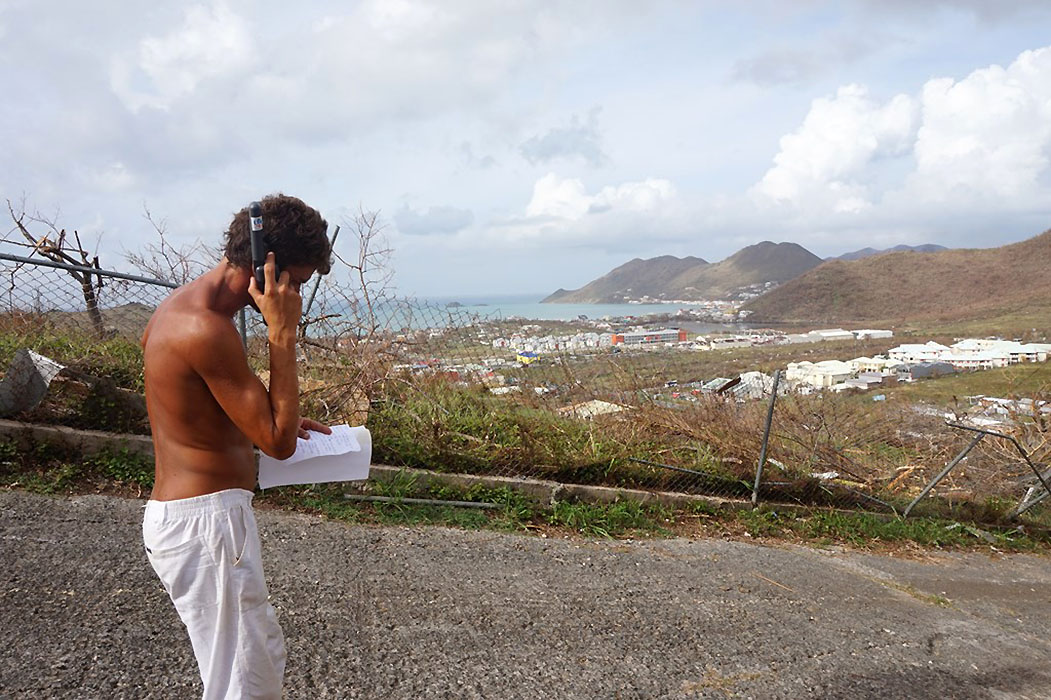Hurricane Irma
Context: Hurricane
Start date: 07/09/2017
End date: 27/09/2017
Areas of intervention: 2 Islands
- Saint-Martin
- Saint-Barthélemy
Activities:
- Telecoms assessments
- Support to coordination
- Humanitarian calling operations
- Connectivity for populations
3 telecom centres for coordination
687 unique users
423 GB of data exchanged for coordination
1 Wi-Fi point for the population
6 humanitarian calling operations
Context
Hurricane Irma formed on 30th August off the coast of Cape Verde. It rapidly gained in force before reaching the West Indies, and continued its progress towards the south of the United States. This tenth tropical cyclone of the 2017 hurricane season in the North Atlantic Ocean proved to be the most powerful hurricane recorded in the Caribbean since Hugo in 1989. It is the first hurricane to remain in Category 5 for such continuous period.
The islands of Saint Martin and Saint Barthélemy, in the direct trajectory of the eye of the hurricane, were severely impacted. On 6th September, Irma hit with category 5 sustained winds of up to 300 km/h. The torrential rains, combined with waves of 10 meters, caused significant floods.
In Saint-Martin, the final toll showed 11 deaths, several hundred injured, 25% of homes destroyed and 40% damaged, public buildings unusable and a shortage of drinking water and electricity.
Deployment
As soon as the alert was received, Télécoms Sans Frontières deployed a team to Pointe-à-Pitre (Guadeloupe) on 7th September in order to deploy to Saint Martin as rapidly as possible. With airports and seaways closed due to the extreme conditions, yet TSF was among the first NGOs to reach the island by boat on 11th September. The team provided the necessary satellite technologies to support humanitarian coordination but also to offer calls to the population living in areas not being covered.
Telecoms assessments
Saint Martin
Local mobile operators, Orange and Dauphin, reported significant damage to their infrastructure across the island, confirming that the majority of the sites were no longer functioning. In addition, the national power grid was down, the telecom infrastructure was no longer supplied.
Saint-Barthélemy
Mobile operators reacted quickly to re-establish lines of communication and set up free services for the population. Nevertheless, TSF assessments identified that some areas remained uncovered six days after the impact, but also that services offered by mobile operators did not work everywhere.
Support to coordination
Saint Martin
In Saint Martin, TSF's first action was to connect the Departmental Operational Centre (COD – Centre Opérationnel Départemental) in order to organize and coordinate emergency response on the island, particularly with the Operational Centres (CO) and the Civil Security unit - which is made up of the civil defence body and the fire brigade. This cell was in charge of logistics on the island, ranging from evacuations to the arrival of humanitarian freight at the port or at the airport.
Two further connections were set up for the coordination of emergency services in Saint Martin:
- The first at the Hope Estate shopping centre requisitioned by the authorities to create a further Operations Centre. This CO is commissioned by the COD to carry out missions such as road clearing, water production and distribution, roofing and accommodation for victims.
- The second connection, located at the airport, is dedicated to the Airport Operations Centre situated in Grand-Case Espérance Airport. Its two core missions are the functioning of the airport (essential for the authorisation of air traffic) and the logistical management of freight items. Equipment and food are dispatched from this platform according to the guidelines given by the COD.
On 27th September the Coordination Centre connections were taken down, leaving just the connection at the Airport to the benefit of the French Forces and Firefighters who were leading relief efforts.
A total of 423 GB of data were exchanged between over 618 key humanitarian relief actors across the three centres.
On the Dutch side of Saint Martin, TSF set up a satellite Internet connexion in collaboration with the emergency team of the Vodafone Foundation, a partner of TSF. This connectivity, installed in the premises of the Red Cross, served for the coordination of aid in the Dutch part of the island, using a total of 76 GB of data.
Saint-Barthélemy
TSF assessments showed that Saint Barthélemy’s principal coordination centres were covered by fibre connectivity. TSF thus concentrated its support on emergency response to affected populations.
Humanitarian calling operations
Humanitarian calling operations were carried out on Saint Martin, particularly in the Orleans area. More than 10 days after the passage of Irma, the vast majority of people who benefited from TSF operations contacted for the first time their families in France or abroad. Given the diversity of the population living on Saint Martin, most calls are made to foreign countries such as Haiti, the USA and the Dominican Republic.
TSF provided the means for the affected population to communicate with their relatives. Teams intervened directly amongst inhabitants to offer telephone calls via satellite. These calls proved vital, with the majority of people not having had contact with their relatives since the disaster.
Connectivity for population
An Internet connection for the population was installed on the island of Saint-Barthélemy in the district of Anse des Cayes, which is one of the most affected neighbourhoods and lacking means of communication. The purpose of this connection was to offer the population the opportunity to reconnect with their loved ones by voice or via social networks, but also to obtain essential information about their situation. A total of 30 GB of data was transmitted through this internet connection for the population.




























